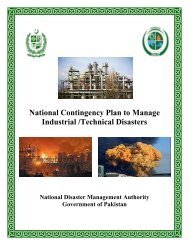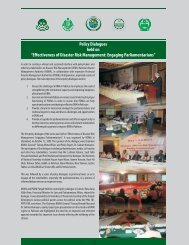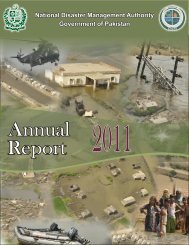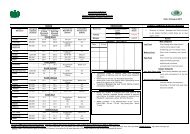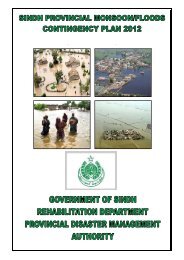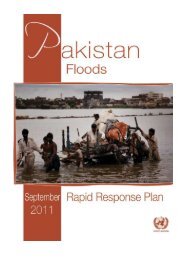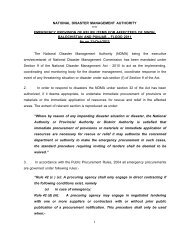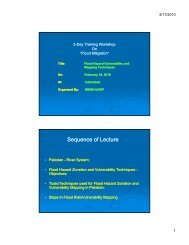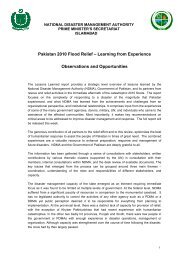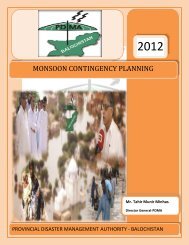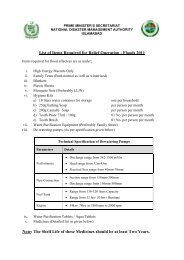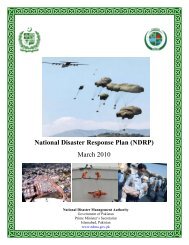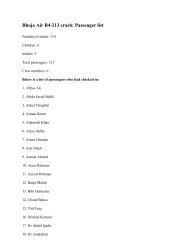District Disaster Management Plan District Kech, Balochistan - NDMA
District Disaster Management Plan District Kech, Balochistan - NDMA
District Disaster Management Plan District Kech, Balochistan - NDMA
Create successful ePaper yourself
Turn your PDF publications into a flip-book with our unique Google optimized e-Paper software.
Functions of DDMA Members<br />
Identification and mapping of all hazards in their respective location and conduct risk and<br />
vulnerability analysis; and<br />
Establishment of civic groups for disaster reduction and relief operations<br />
The appropriate structure of the <strong>Disaster</strong> Risk <strong>Management</strong> organization at Tehsil and Union<br />
Council level will be determined by the DDMA within the first 6 months of this plan<br />
7.19 Union Council<br />
Conduct orientation programs in their respective local areas/villages illuminating disaster<br />
oriented awareness<br />
Keep abreast to the district <strong>Disaster</strong> <strong>Management</strong> Authority (DDMA) regarding needs and<br />
requirements of the local masses<br />
Preparation of plans and procedures for disaster management programs in their respective<br />
locations<br />
Take operational control in the event of a disaster or emergency so as to make sure that timely<br />
and required support is ensured to the affected households<br />
Mobilization of required finance and material resources for disaster management<br />
Identification and mapping of all hazards in their respective locations and conduct risk and<br />
vulnerability analysis<br />
Establishment of civic groups for disaster reduction and relief operations<br />
The appropriate structure of the <strong>Disaster</strong> Risk <strong>Management</strong> organization at Tehsil and Union<br />
Council level will be determined by the DDMA within the first 6 months of this plan<br />
7.20 Media<br />
Provide analysis on sources and process of risk generation and patterns of risk and<br />
vulnerabilities;<br />
Disseminate warning messages to at risk communities in an easy to understand language<br />
through multiple channels, while being sensitive to people's access and timing issues;<br />
Provide information to communities about precautionary measures they can take to avoid loss of<br />
life and property from hazards;<br />
Advocate to decision-makers to take appropriate actions for disaster risk management;<br />
Highlight the need for involvement of communities in disaster preparedness;<br />
Inform the public with timely and factual information about the extent of disaster, losses caused<br />
and the current situation of hazard;<br />
Advise public about actions to be taken during the emergency period in order to avoid further<br />
losses; e.g. evacuation, unsafe areas, water purification techniques<br />
Inform about actions being taken by authorities/aid groups to save lives and property;<br />
Relay messages concerning welfare of isolated or trapped groups for the benefit of families,<br />
relatives, friends and rescue teams;<br />
Facilitate communication among affected people and their relatives, friends, families in other<br />
parts of the country or world;<br />
Highlight needs of survivors to make sure that all groups of people affected by the disaster<br />
receive appropriate aid, irrespective of their social, ethnic, political status;<br />
Highlight the need for application of minimum standards to ensure that minimum needs of<br />
disaster survivors in terms of water, sanitation, shelter, food and health are met;<br />
Communicate about potential secondary risks to minimize further loss or damage;<br />
Appeal for assistance from all parties to meet the needs of survivors;<br />
33



